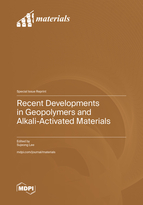Recent Developments in Geopolymers and Alkali-Activated Materials
A special issue of Materials (ISSN 1996-1944). This special issue belongs to the section "Construction and Building Materials".
Deadline for manuscript submissions: closed (10 April 2023) | Viewed by 22738
Special Issue Editor
Special Issue Information
Dear Colleagues,
The Special Issue, “Recent Development in Geopolymers and Alkali-activated materials”, will address advances in characterization, processing, scale-up, and commercialization of various types of geopolymers, geopolymer composites and alkali-activated materials. Geopolymers and alkali-activated materials have not been viewed as a substitute for Portland cement in bulk applications despite their high potential with excellent properties in niche applications. However, geopolymers and alkali-activated materials represent one of the most efficient approaches to address urgent environmental issues such as CO2 emissions. Huge amounts of coal ash and slags are discharged from around the world. Alkali activation is a good option for inertization and utilization of mine tailings and other solid inorganic residues formed in the metal and mining industry and energy production. Geopolymers can be a candidate for building moon bases as part of a space exploration plan. Original papers are solicited on all types of geopolymers and alkali-activated material production technologies. Of particular interest are recent developments in advanced processes, characterization, performance, and commercialization. Articles and reviews dealing with geopolymers and alkali-activated materials for different market applications, including a substitute for Portland cement with special purposes such as ash nuclear waste storage, fire-resistant building materials, ceramic precursors as well as other niche applications, are very welcome.
Dr. Sujeong Lee
Guest Editor
Manuscript Submission Information
Manuscripts should be submitted online at www.mdpi.com by registering and logging in to this website. Once you are registered, click here to go to the submission form. Manuscripts can be submitted until the deadline. All submissions that pass pre-check are peer-reviewed. Accepted papers will be published continuously in the journal (as soon as accepted) and will be listed together on the special issue website. Research articles, review articles as well as short communications are invited. For planned papers, a title and short abstract (about 100 words) can be sent to the Editorial Office for announcement on this website.
Submitted manuscripts should not have been published previously, nor be under consideration for publication elsewhere (except conference proceedings papers). All manuscripts are thoroughly refereed through a single-blind peer-review process. A guide for authors and other relevant information for submission of manuscripts is available on the Instructions for Authors page. Materials is an international peer-reviewed open access semimonthly journal published by MDPI.
Please visit the Instructions for Authors page before submitting a manuscript. The Article Processing Charge (APC) for publication in this open access journal is 2600 CHF (Swiss Francs). Submitted papers should be well formatted and use good English. Authors may use MDPI's English editing service prior to publication or during author revisions.
Keywords
- Geopolymers
- Alkali-activated materials
- Coal ash
- Slags
- Mine tailings
- Characterization
- Processing
- Scale-up
- Commercialization
- Niche application







